R-20 Album
Notes
Running On The Surface ~ Deck Gun Raised
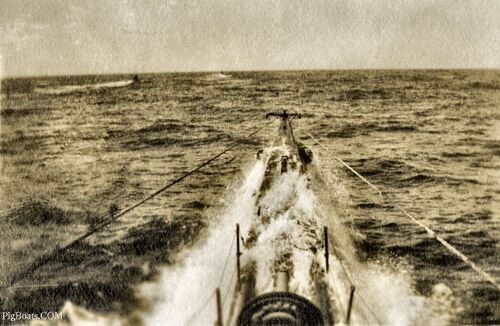

This next photo in the sequence shows the wave covering the deck and putting the gun underwater. It was unusual to leave this particular gun in the raised position while proceeding on the surface at speed and in these kind of seas.
One of the major reasons to make the gun retractable was to protect it from seawater induced corrosion, reducing maintenance requirements. With the waves inundating it in this fashion, the gun would have required careful and intensive maintenance once the boat returned to port.
Other submarines, most likely squadron mates, can be seen directly ahead and off the port bow. It is possible that the boats were proceeding to a gunnery training area when these photos were taken.
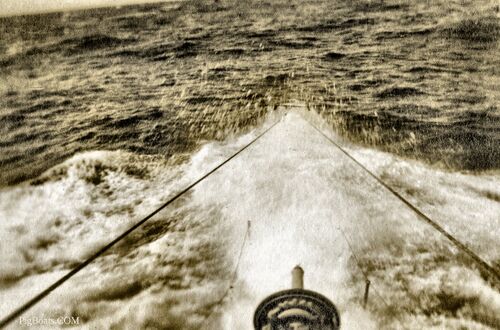
The R-20 continues to pound through the swells, temporarily submerging the entire forward deck all the way up to the gun, whose circular shield can just be seen.
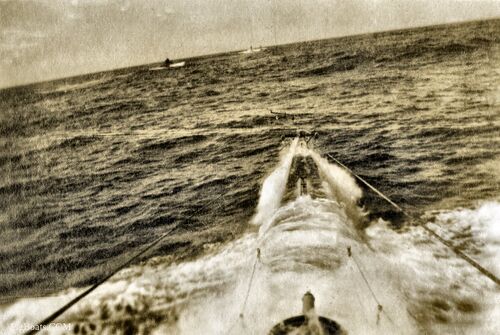
The R-20 continues driving through the ocean swells off the Southern California Coast. Probably for some Torpedo and maybe Gunnery practice.
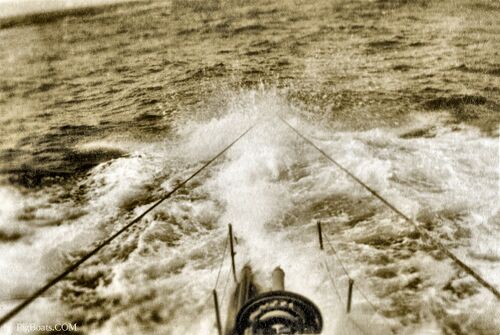
The R-20 continues driving through the ocean swells off the Southern California Coast. Once again the swells have submerged the entire forward deck.
Running On The Surface ~ Deck Gun Housed
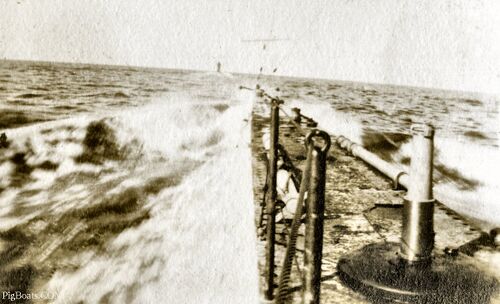
It is not known if this and the next photo were taken at the same time as the photos above. In this photo the gun has been retracted into a watertight tub that penetrated the pressure hull down into the forward battery room. The circular gun shield forms a watertight “hatch” that protected the gun breech and the elevation and training mechanisms. A tampion is inserted into the muzzle end to protect the rifled bore from corrosion.
Out of sight in this photo is the recoil dampening cylinder, which also penetrated the gun shield. It is behind the barrel. Lifelines and stanchions have been put in place on the edges of the deck to give the gun crew some level of protection from falling over the side.
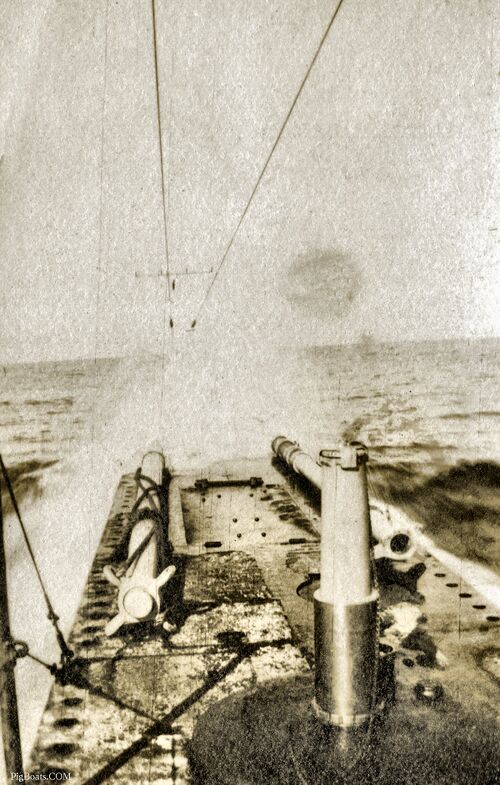
Another angle looking almost directly forward on the deck with a good look at the gun barrel. The two tubes or pipes on the deck are the torpedo loading mast and boom in their stowed positions. Later, when the larger deck gun will replace this one, these will be stored on the after deck leaving more room to train and point the large weapon.
The large rectangular deck hatch is the opening into the superstructure giving access to the slanted torpedo loading hatch below it. It has a dual purpose. First, to act as a deck cover for the opening, and secondly to act as a slanted loading ramp for the torpedo to rest and slide on. Its hinges are on the after end of the hatch and it folds up and back making the ramp.
Firing a Torpedo
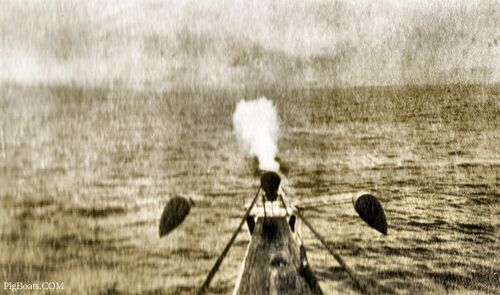
The R-20 fires a practice torpedo with a non-explosive water filled warhead from either her #1 or #3 torpedo tube. As it exits the tube, after approximately 100 or so feet, it broaches the surface before diving back to its set running depth.
The puff of "smoke" is actually steam, as the Mk 9 and Mk 10 Bliss-Leavitt torpedoes used by the R-boats had a wet-heater type engine. This engine used an alcohol fueled flame to heat water into steam, which then spun the turbine to turn a dual contra-rotating propeller.
The weapon left a trail of combustion gases and steam in its wake, creating the characteristic white trail behind it. If the weapon broached it would leave a puff of steam in the air. Broaching was neither intended nor desired, as it gave warning to the target of the approaching torpedo.
These torpedoes had notoriously finicky depth keeping mechanisms, sometimes following a "sine wave" style up and down course to the target, with obvious negative implications to accuracy.
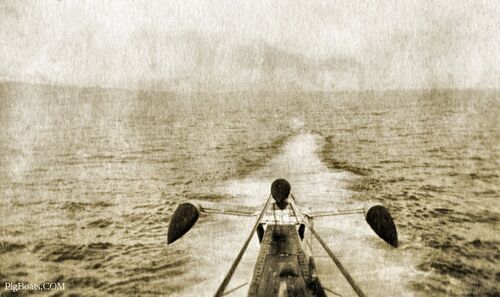
As the R-20 continues running on her assigned course, following the fired torpedo, its track of exhaust bubbles spreads out behind it. The next job for the R-20 will be to locate the torpedo and hoist it back aboard. It is then carefully lowered down into the torpedo room to be returned to the Naval Station for overhaul by the torpedo shop, and will be eventually reused.
The large wing-like array on the bow is the Y-tube sonar. It consists of three hydrophones covered by a flexible streamlined rubber "rat" that smooths the flow of water over the hydrophone, reducing ambient noise. The hydrophone wings are attached to a prominent U-shaped bracket that raised them above the deck, allowing a towing hawser to pass underneath.

The track of exhaust bubbles thins out behind the fired torpedo as the R-20 continues to follow.
Retrieving the Torpedo
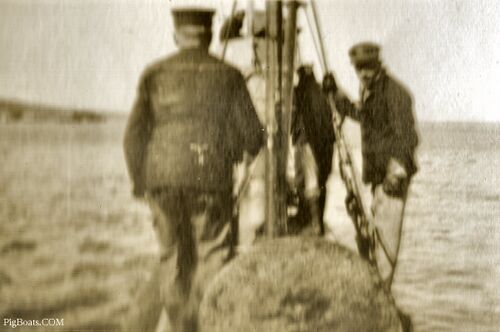
At the time frame this photo was taken it was not unusual for submarines during torpedo training exercises to locate and retrieve their fired practice torpedo. That is what is happening here. The torpedo fired in the above sequence has now been picked up and hoisted onto deck and is being loaded back down into the submarine. Once back in port the torpedo will be pulled out of the submarine in a reverse of the procedure seen here, and it will be sent to a tender or shop ashore for refurbishment and reuse.
With his back to the camera is most likely a Chief Gunners Mate with a Torpedo rating. The rate of Torpedoman did not yet exist. On the right the other man looks to be an officer supervising the process.
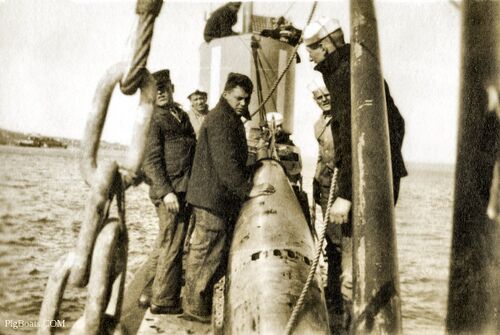
The Chief on the left seems to be paying attention to something or somebody who is forward of the camera.
A block and tackle is attached to the rear of the torpedo and the front of the bridge. This is to control the rate of descent of the torpedo. These weapons were 21 inches in diameter and 16.3 or 16.7 feet long. They weighed between 2200 and 2400 pounds each. Careful control of this much weight was vitally important. Amazingly, note the complete lack of lifelines for the safety of the crew. The Chief on the left is dangerously close to going over the side. One wrong move by any of the loading crew and someone gets wet.
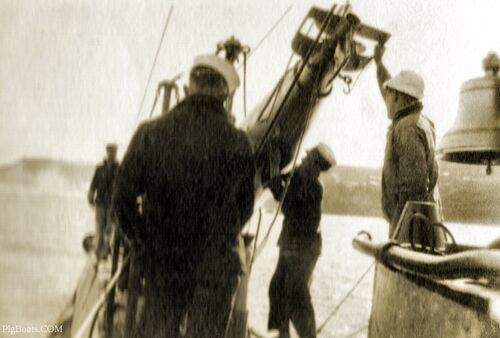
The view looking forward as the weapon is lowered into the torpedo room. The officer is forward watching the operation. No sign of the Chief. Note the control arrangement on the tail of the torpedo. The contra-rotating propellers were intended to counteract the rolling torque of the torpedo’s engine. Without them the weapon would continuously roll along its axis after firing making depth and course control impossible.
Just to the right of the man closest to the camera hip is the barrel of the 3"/23 caliber deck gun. The gun is in its housed position.
The Crew

Nine men and a Chief. This looks a lot like an inport duty section. This is approximately one third of the crew size for this vessel.
A "Duty Section" comprises enough men to be able to take the vessel to sea and be able to fight it, if necessary, for a limited amount of time. Each section would have enough men to man the important duties aboard. The good thing about submarines and the training the crew have is the ability to know each others jobs and be able to navigate and fight the ship as necessary.
Note the man who is 5th from the left is wearing unique boots. He is seen several times throughout in these photos.

This looks to be three officers on the bridge of the R-20. One is likely to be LCDR Alfred E. Montgomery, the Commanding Officer of the USS R-20. The names of other officers have not been located at this time.
This is a good view of the boat’s open-air bridge and periscope support shears. One officer is sitting between the two periscopes, and the third mast on the right is an extendable radio antenna mast. Just aft of the radio mast is a navigation light.
The wires connected to the angled brackets are mine and/or harbor defense net clearance wires. They can be seen more clearly in the photo below.
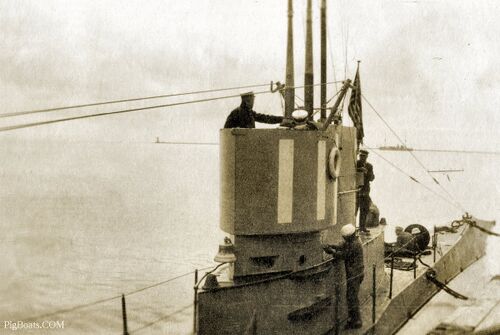
An officer on the bridge of the R-20. It could be LCDR Montgomery, the Commanding Officer. Another officer is to the right side of the bridge but only the top of his hat can be seen. An enlisted sailor works on something on the side of the fairwater and perhaps a Chief is on the aft fairwater deck.
This is a good view of the R-20’s conning tower fairwater, and the clearance wires can clearly be seen. The conning tower itself is a small vertical cylinder, just big enough for two to three men to stand upright, and it contained a periscope station for #1 scope. It also had four very small glass windows, called deadlights, and two of them can be seen just to the left of the sailor standing on deck. The conning tower is surrounded by a metal framework and plating called the fairwater, with the purpose of smoothing the flow of water around the tower, the periscopes, ventilation piping, and the bridge.
Looking at the bracing for the clearance wires you can see the "hooks" where the portable running lights were mounted. The red and green navigation lights were hung on these hooks and plugged into a water proof receptacle to supply them power.
In the background it looks like the Los Angles Lighthouse sitting on the end of that long breakwater.
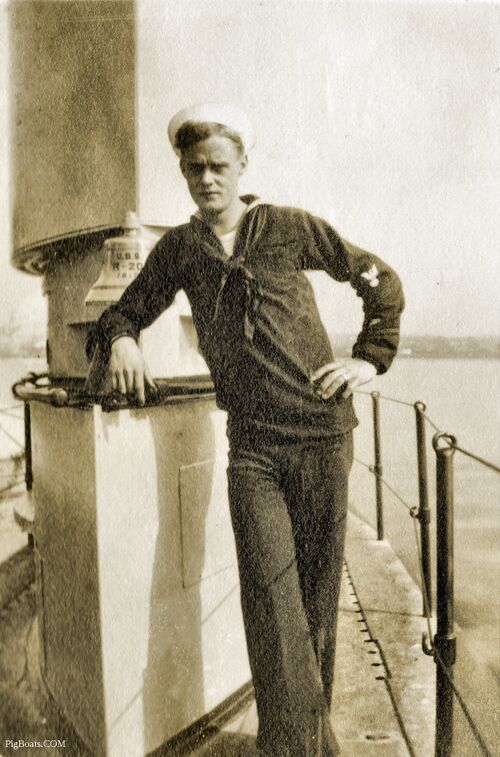
Nice portrait of an R-20 sailor. He is an Electrician (Radio) 1st Class with two hashmarks meaning over eight years of service. This could be the photo album's owner. The man is married judging by the ring on his left hand.
The Deck Gun

This is a good photo of the business end of the 3"/23 caliber Mk 9 "disappearing" deck gun. This weapon had a vertically sliding breech block and used fixed ammunition (i.e. shell and propellant put together in a brass cartridge, similar to a rifle bullet).
The base of the mount had brackets that held ready-use rounds that could be immediately loaded and quickly fired upon surfacing. One round can be seen adjacent to the knees of the Sailor on the left. Additional ammo was stored below and would be brought up by crewmen formed into a passing train.
The end of the recoil cylinder can be seen just below and to the left of the barrel. The weapon was light weight and easy to use, and when retracted into its tub provided little underwater drag. However, it was a low powered weapon that fired shells with little punch. It didn’t have the power necessary to finish off targets quickly. There have also been reports of the gun having a nasty tendency to retract into its tub with the recoil of firing. This had obvious negative safety implications for the crew.
The following is part of a paper written by Submarine historian Jim Christley. This describes what a deck gun is and this gun in particular:
A deck gun type is defined by its bore diameter and bore length. Further refinement of the gun type is by the Mark and Modification number. The bore diameter is normally given in inches and the bore length is given in calibers. A caliber is one bore diameter. Thus, for a 3"/50 gun, the bore diameter, measured land to land is three inches. The length of the bore is 50 calibers or 150 inches. Each major type also was given a Mark number by the Bureau of Ordnance (BuOrd). A gun could have the same bore size and length and be a different Mark. When discussing the entire range of 3" guns in the Navy, it is useful to use the Mark number. For submarine guns only, is normally not necessary. Modifications to a particular Mark were also numbered. Thus, a gun was fully described with its bore diameter, bore length, Mark and Mod numbers.
The 3"/23 is the Navy’s early attempt at creating a dual-purpose gun. That is a single weapon that would be used both as an anti-surface and anti-aircraft gun. The diminutive 3”/23 Mark IX. It fired a projectile of about 13 pounds to a range of about 4.5 miles. Used in submarines it had no remote fire control system and was used in line of sight only. The mount was retractable in that the barrel assembly could be rotated to 90 degrees in elevation and the whole thing lowered into a containment cylinder. What appears as a splinter shield was the watertight cover that fitted snugly to the top of the containment. The gun’s drawbacks were that it had a fairly short range and it was prone to retracting when fired or at other inopportune times. Thus, one kept one's toes away from the containment rim.
The man second from the right is wearing the same boots as was noted in an above photo.
On the Pier
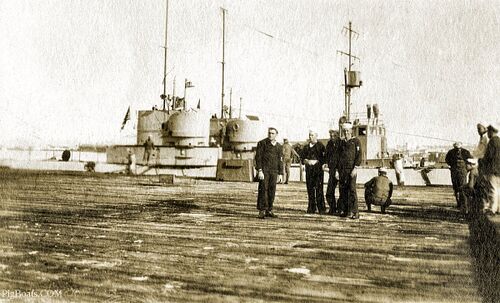
This photo was taken only a few minutes after the one above. Several R-20 crewmen are on the pier and seem to be interested in something going on behind the camera man. One man is in dress blues and the others seem to be in undress blues or working uniforms.
Looking Astern
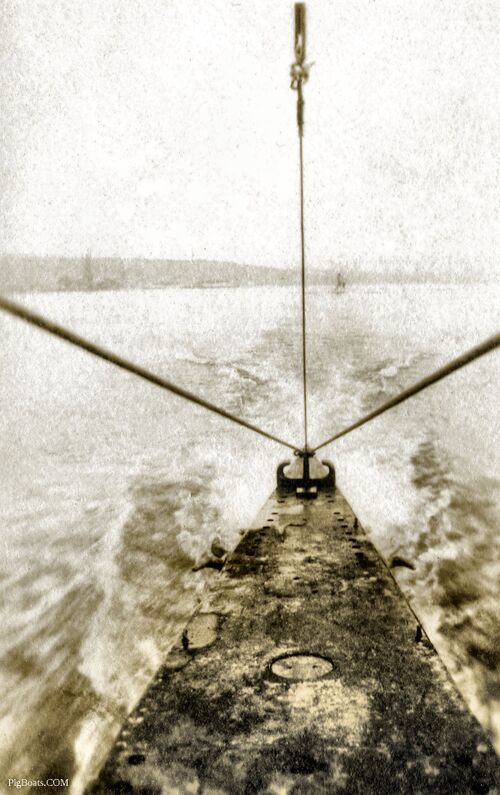
View looking astern as the R-20 pulls away from harbor. Which harbor is not clear. It could be San Pedro (Los Angeles) or San Diego. An unidentified submarine is following behind.
The terminus for the clearance wires can be seen on the aft deck, along with an open top towing fairlead chock. There are also two other mooring line cleats attached to the edges of the deck. Their intended use is to secure mooring lines to the pier while in port.

View astern from the bridge with the underway colors flying in the breeze. There looks to be a signal halyard that has come loose.
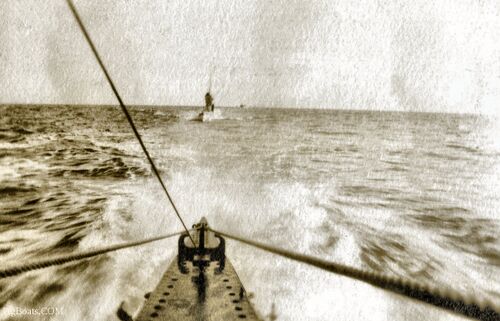
Another stern view with a following submarine and another unidentified ship behind that.
After Deck
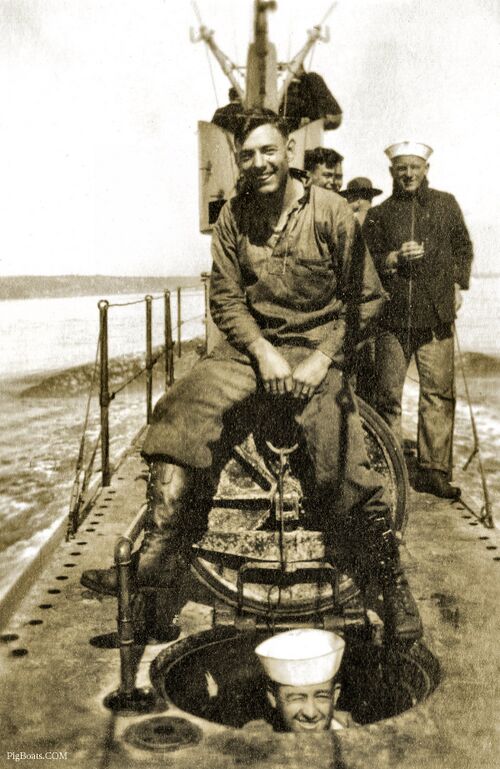
Sailors relaxing topside during the Maneuvering Watch inbound to port. The man sitting on the open engine room hatch and happily posing for the camera is wearing the same unique boots that has been seen several times above. By the ring on his left hand he is also a married man.
These boats had no air conditioning and poor ventilation and it tended to get very hot and stuffy below decks. Whenever it was possible, and when the Captain allowed, they would come topside for some relief from the conditions below.
Gun Sponson Addition

R-20 and two more R-boats in dry dock at Mare Island Navy Yard, California in March 1919, undergoing prep work for the homeport shift to Pearl Harbor.
The hull below the waterline has been scraped to prepare for painting. There also appears that work is in progress on the forward deck, where the 3"/23 caliber gun was removed. The deck structure where the gun was mounted and housed has been opened up to remove the "tub" that passed through the pressure hull. This hole was patched and a new wider deck installed to accommodate the new larger gun. This deck would later have supporting sponsons constructed under it.
The half cone shaped fairings on the forward superstructure are for the bow planes operating mechanism, smoothing the flow of water over them while submerged. The bow planes themselves are folded back against the superstructure in their retracted position.
Starting about midships down towards the bottom of the boat is the port side bilge keel. This device (there is one on the starboard side as well) is intended to reduce rolling on the surface that is caused by wave action.
Notice that the bracket for the Y-tube sonar is now mounted closer to the deck than in the above photos. The reason for this change is most likely related to water flow vibration that reduced the effectiveness of the hydrophones.
Upon completion of the work on June 17, 1919 the R-20 got underway for Pearl Harbor in company of her squadron mates.
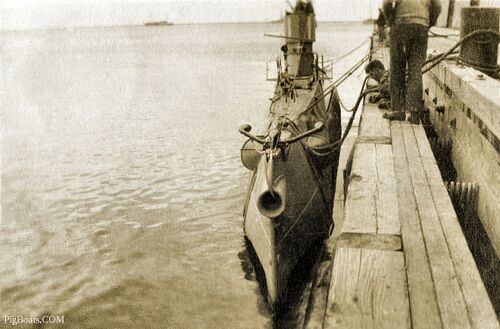
Bow on shot with the boat sitting alongside a pier possibly at Mare island. The beginnings of an expanded sponson for the soon to be installed 3"/50 caliber gun can be seen just forward of the conning tower fairwater.
Hawaii ~ Pearl Harbor
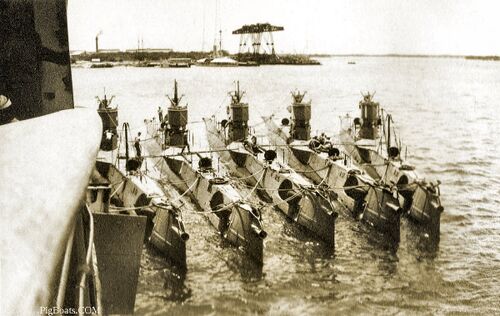
Moored at the Naval Station Pearl Harbor, T.H. summer 1919. The main part of the Pearl Harbor Navy Yard can be seen in the background, with the prominent cantilever pontoon crane YD-25 clearly in view.
L to R are the submarines R-19, R-18, R-15, R-17, and R-20. Note that the expanded sponsons for the 3"/50 caliber gun have now been completed, but the gun and its mount have yet to be installed.
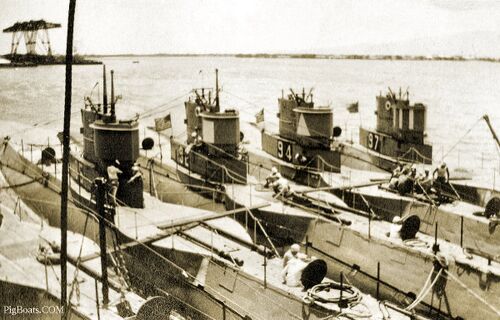
Similar photo as above but from a different angle. The R-19 and the R-20 have their torpedo handling masts set up and the R-20 has also rigged the boom. The boom for the R-19 is still laying on the deck. It seems the masts and booms offer opportunistic seating for off duty crews. Note that the boat's are displaying their hull numbers instead of their names. Although it became the Navy standard after 1938, during this period it was a rare practice.
Interior Tour
Torpedo Room
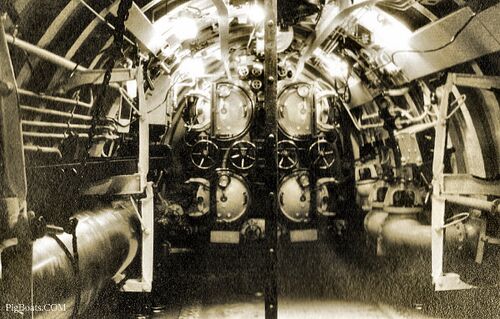
The business end of the R-20. There were four torpedo tubes that could fire a selection of torpedoes:
•The Mk 9 Mod 1B - 16.3 feet long, 21 inches wide, range 5500 yards @ 34.5 knots, warhead 396 lbs. TNT later Torpex
•The Mk 10 Mod 0 - 15.25 feet long, 21 inches wide, range 5000 yards @ 30 knots, warhead 400 lbs. TNT
•The Mk 10 Mod 3 - 15.25 feet long, 21 inches wide, range 3500 yards @ 36 knots, warhead 497 lbs. TNT or 485 lbs. Torpex
The submarine carried eight torpedoes. Four in the tubes and four reload. One of which can be seen in the lower rack on the left side of the photo.
The vertical bar in the center of the photo is the side rail of the ladder that descends from the torpedo room deck hatch.
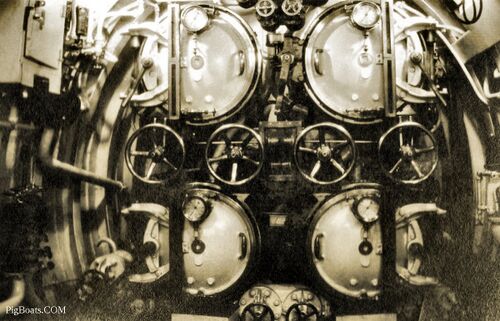
A closeup of the torpedo tube inner, or breech, doors. Once submarine construction moved away from rotating bow caps that covered the outer ends of the tubes the numbering sequence of the tubes changed. These tubes seen here are numbered odd and even, starboard side and port side. The two tubes on the right or starboard side in the photo are, from top to bottom, tube #1 and tube #3. The two tubes on the left are tube #2 and tube #4.
The row of handwheels across the center between the tubes are for opening and closing the tube outer doors and the shutters that cover them.
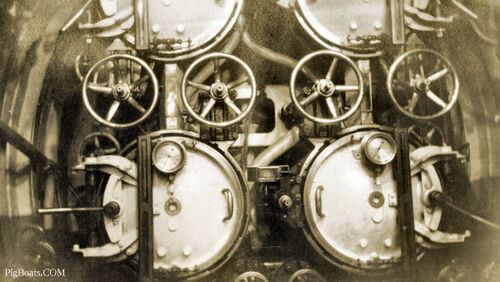
A closer look at the torpedo tube doors. Each door has the same equipment on it. Each has a sight glass to show if the tube has water in it. Each has a gauge to see if there is any pressure behind the door before opening. Each door has a locking handle to rotate the locking ring into place. Hard to see but at the bottom of the doors is a small valve to equalize the pressure or sound the tube for the presence of water.
Forward Battery Compartment/Berthing

Forward battery compartment looking forward into the torpedo room. Inside the torpedo room the lower skirt and ladder for the forward deck hatch can be seen.
At the right in the photo is a large cabinet where six M1903 Springfield rifles are stored. Submarines of this period also routinely carried at least one Lewis Mk VI light machine gun and several M1911 .45 caliber pistols for their force protection needs. Three of the rifles are hung barrel up and three barrel down to better accommodate the volume they take up. A small fire extinguisher hangs beside the watertight door. A large fan to move air about the compartment is in the overhead.
Crew lockers are seen on both sides of the space. Part of this space was berthing for the officers. This was on the port side of the room and curtained off from the rest of the crew. Crew berthing occupied the rest of the room. The large rod seen in the port overhead is the mechanical drive rod for the bow planes operation. Below the deck was one half of the submarine's battery, 60 man-sized battery cells.
Control Room
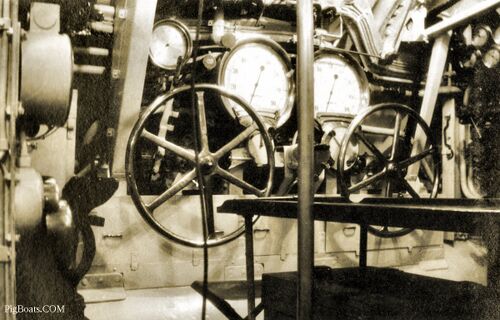
This view shows the control wheels for the stern and bow diving planes on the port side of the control room. Between the two wheels are depth gauges, and at the bottom of the gauges are angle indicators used to determine if the boat is on an even keel.
This is the smallest compartment on the submarine. It is also the busiest. The equipment at the left in the photo is the motor controller station. This area will later evolve into the maneuvering room and be moved aft on the larger fleet boats.
What is probably a navigation table is seen on the right half of the photo. It was a place to spread out charts and work out courses and also a place to plot attacks on targets.
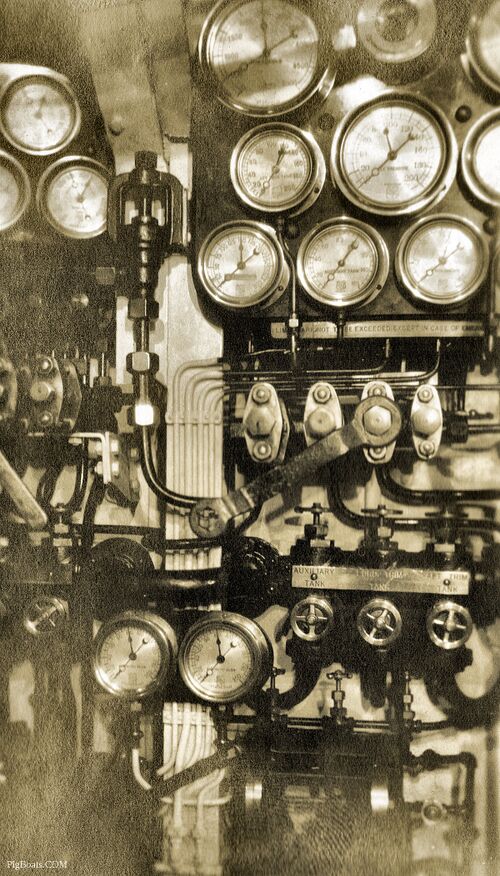
This is a high pressure air manifold used for blowing the ballast tanks, on the forward bulkhead of the control room. The top row of dials shows, left to right; a gauge marked "Air Flask". The center is a barometer. On the right is a gauge marked "Air Manifold".
The center row, left to right the dials say: "Aft Trim Tank"; "Sea Pressure" and "Fwd Trim Tank".
The bottom row of dials say; "Regulator"; "Auxiliary Tank"; "Aft Main Ballast" and "Fwd Main Ballast".
A double ended wrench used to operate the valves can be seen on one of the operating valves in the center of the picture.

This view is the control room starboard side looking forward. The forward battery compartment can be seen through the watertight door. The first four of eight Kingston valve control levers is seen on the right. The Kingston valves were used to close off the bottom of the main ballast tanks.
Trim Manifold is seen in the center of the photo with the controller for the trim pump, it is the large box with a hand wheel on it above.
Seen above the trim pump are storage locations for a Lewis Mk VI light machine gun that fires 30-06 cartridges, and behind that looks to be a M1918 Browning Automatic Rifle, commonly known as a BAR, that fired the same round.
The vertical objects are large sight glasses that displayed the fluid levels of the auxiliary tanks, better known at that time a adjusting tanks. These tanks held varied amounts of ballast water used to adjust overall buoyancy. The goal while submerged, rarely achieved, was perfect neutral buoyancy, neither rising or sinking.
After Battery Compartment/Messing/Electrical

This is the after battery compartment, just aft of the control room. It contained half (60 cells) of the boat’s large lead-acid battery below the walking deck. Above the deck was the boat’s galley and crew eating spaces. The other half (another 60 cells) of the boat’s battery was located in a compartment forward of the control room, with the upper half of the compartment being used as a berthing space.
The periscope is an early Kollmorgen design. This periscope was removed from the R-Boats in 1924. It was 18 feet 10 1/2 inches in length and 6 inches in diameter. It had an 8 degree field of view at 6 power. At low power (1.25 power) it gave a 38 degree field of view. See the R-16 (SS-93) page for more information on this periscope.
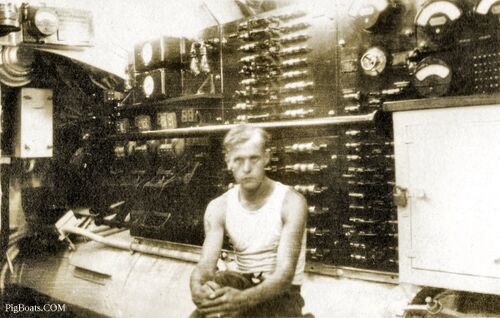
This is the main electrical switch board on the starboard side forward in the after battery compartment. At left above are two large boxes with the round dial are amp hour meters for the forward and after batteries. See the R-16 (SS-93) page for more information on this electrical equipment.
Engine Room
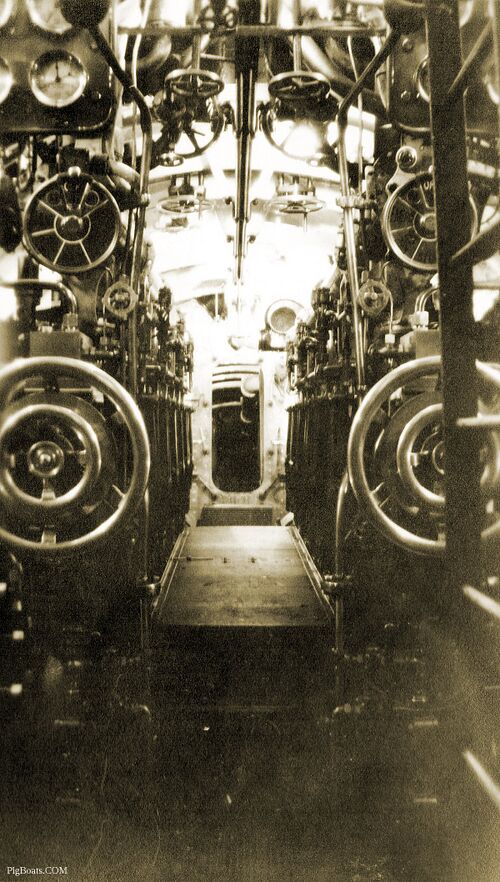
This is the engine room looking aft. These engines are six-cylinder NELSECO 6-EB-14 direct drive models. Diesel-electric drive was still 15 years in the future. They were rated at 440 BHP and proved to be reasonably reliable in service. However, scaled up versions of this engine were installed in the follow-on S-class and were complete failures. Seen in the upper foreground are the engine order telegraphs above the throttle wheels on the front of the diesels.
Motor Room
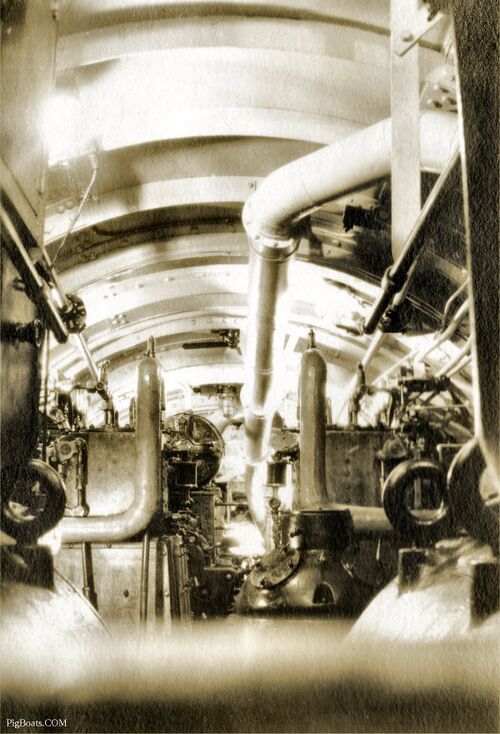
Motor Room looking aft. In the foreground, the domed object is the low pressure ballast pump. A ventilation duct runs down the center of the overhead and just aft of the matching curved pipes, on either side of the room are the shaft driven air compressors.
The main electric motors that drive the shafts when submerged are seen as the curved objects in the foreground. A large electric motor just to the left of center is believed to be for the high pressure ballast pump.
A few pieces of the equipment seen farther aft could be the lathe and drill press but detail is lacking to make positive determinations.
Miscellaneous Photos from the Album
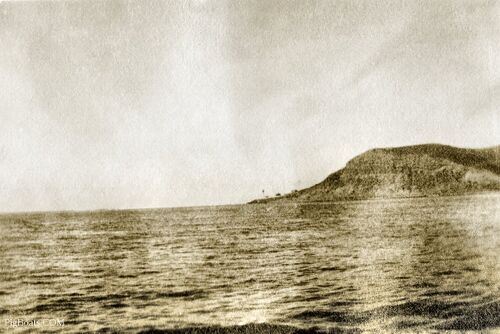
The album also contained several pictures with no submarine in it! This is the Point Loma headland at the entrance to San Diego Bay. At the time of this photo, submarines and their tender were based near downtown at Naval Station San Diego near 32nd Street. In modern times, submarines operate out of the Naval Submarine Base San Diego, an adjunct to Naval Base Point Loma, established on the grounds of the former Fort Rosecrans, just to the right of this photo.
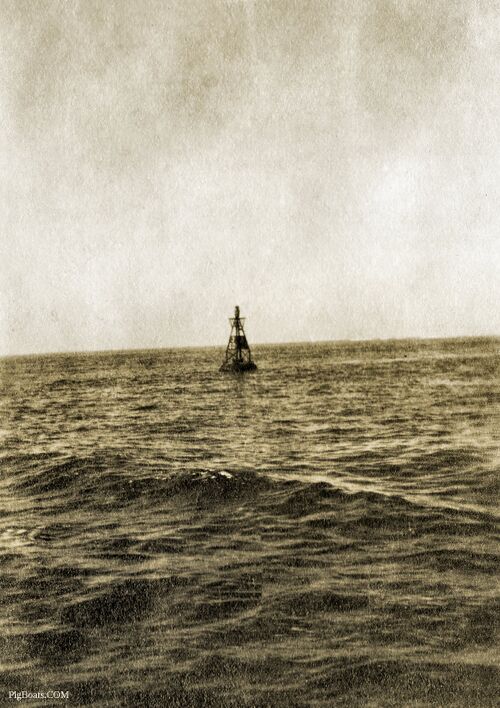
This was the entrance marker for San Diego Bay. Buoy #3 with the letters SD marked the entrance to the channel for many years.
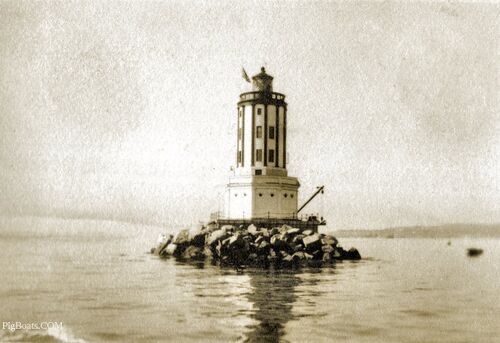
The Navy maintained a small submarine base at San Pedro, California, on the outskirts of Los Angeles for many years during the 1920's. Submarines were a frequent visitor to the City of Angels during this time. This photo is of the Los Angeles Harbor Lighthouse, which still stands to this day.
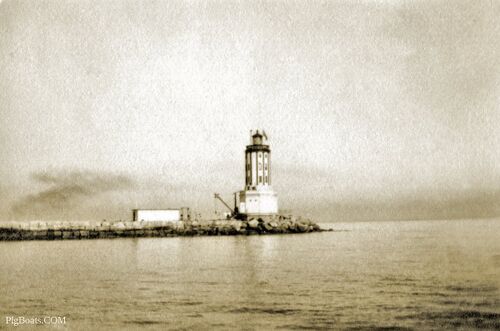
Another view of the Los Angeles Harbor Lighthouse, sitting on its perch at the end of the breakwater.
Page created by:
Ric Hedman & David Johnston
1999 - 2023 - PigBoats.COM©
Mountlake Terrace, WA, Norfolk, VA
webmaster at pigboats dot com
